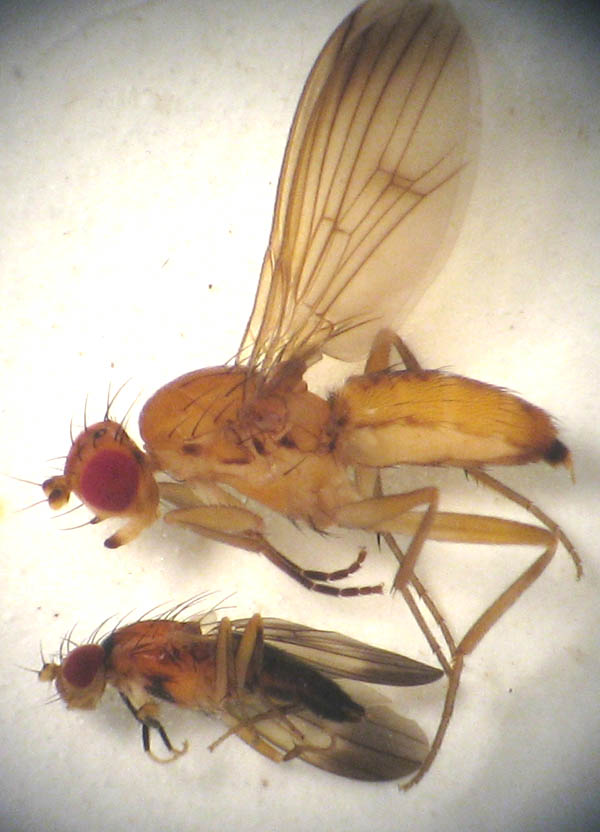Diptera.info :: Identification queries :: Diptera (adults)
Who is here? 1 guest(s)
|
Lauxaniidae/Sciomyzidae/??????
|
|
| Gordon |
Posted on 20-10-2008 11:41
|
|
Member Location: Lake Kerkini, Greece Posts: 1101 Joined: 02.01.08 |
This one has me feeling a bit stupid, at first glance I assumed it was a Sciomyzid, but then I thought to check the book to make sure it wasn't a Lauxaniid, and it seems it is neither. Both the above families have 2 pairs of F-bristles as well as P-Bristles. As the inset clearly shows this has 3 pairs of F-bristles and no P-bristles. Wetland Kerkini: Greece. 25 May to 1st June 2008 1485 m ASL. Thanks Gordon attached the following image:  [77.07Kb] |
| Jan Willem |
Posted on 20-10-2008 12:24
|
|
Member Location: Waalwijk, The Netherlands Posts: 2161 Joined: 24.07.04 |
My first impression was Clusiidae.
Jan Willem van Zuijlen |
|
|
|
| Gordon |
Posted on 20-10-2008 13:11
|
|
Member Location: Lake Kerkini, Greece Posts: 1101 Joined: 02.01.08 |
Dear Jan, Thanks for the comment, yes I can see why you would suggest that, however I neglected to mention its size, circa 8mm, which is large for Clusiodes as Lonsdale and Marshall put the upper limit at 5.8 mm, see new image with a specimen of C. albimanus for comparison. Gordon attached the following image:  [78.06Kb] |
| Paul Beuk |
Posted on 20-10-2008 13:42
|
|
Super Administrator Location: Netherlands Posts: 19403 Joined: 11.05.04 |
In this case you would be looking at Clusia flava, I think, which can be considerably larger than Clusiodes.
Paul - - - - Paul Beuk on https://diptera.info |
| Gordon |
Posted on 20-10-2008 15:11
|
|
Member Location: Lake Kerkini, Greece Posts: 1101 Joined: 02.01.08 |
Ahh well, I have no literature for that species unfortunately, the Clusiodes paper describes Hendelia beckeri but does not mention the genus Clusia. Thanks Gordon |
| Jan Willem |
Posted on 20-10-2008 22:31
|
|
Member Location: Waalwijk, The Netherlands Posts: 2161 Joined: 24.07.04 |
Stubbs (1982) says in his key: 3. The most anterior pair of orbital bristles (bristles close to the top eye margin) curve inwards towards each other, in contrast to the more posterior pair/pairs. Thorax completely black or abdomen yellow ............................................4 - All orbital bristles curved upwards and backwards. Thorax partly pale, abdomen never yellow .................. Clusiodes 4. Thorax and abdomen entirely black (small species like Clusiodes) .................................. Heteromeringia - Thorax and abdomen entirely yellow, or only very narrow black stripes on thorax ................................... Clusia Following this, your specimen belongs to the genus Clusia. And since there is only one Clusia species in Europe it should be Clusia flava. Edited by Jan Willem on 20-10-2008 22:33 Jan Willem van Zuijlen |
|
|
|
| Gordon |
Posted on 21-10-2008 05:00
|
|
Member Location: Lake Kerkini, Greece Posts: 1101 Joined: 02.01.08 |
Dear Jan, Thanks a lot for that, it is nice to add another species. I have just now been looking through the Sciomyzids from nearby weeks and sites hoping find another specimen. Unfortunately, but perhaps happily, I have not found any yet. Gordon |
| Jump to Forum: |













